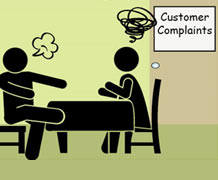
Poster from one of the Myth Buster Challenge Panel campaigns
Study uncovers the reason behind health and safety myths
New research from the University of Exeter reveals some of the complex reasons why health and safety regulations are used incorrectly and blamed for over-the-top decisions.
Retail and leisure businesses feature prominently in the study which analysed over 250 cases submitted by members of the public to the government’s Health and Safety Executive’s (HSE) Myth Busters Challenge Panel, which was set up to refute inaccurate or excessive decisions made for health and safety reasons.
Examples of cases submitted to the HSE by bemused customers include being told by a leisure centre that they wouldn’t lend floats or goggles to use in the swimming pool for health and safety reasons. Although, January is traditionally a time when people want to get healthier, customers are being left increasingly frustrated by ridiculous decisions made in the name of health and safety, more often than not to cover up what is simply poor customer service.
The research led by Dr Claire Dunlop, a senior lecturer in Politics at the University of Exeter looked at perceptions and understanding of health and safety regulation in society. It found the fear of being sued; cost avoidance and lack of training were key reasons in addition to poor customer service behind the use of the health and safety myth.
According to the independent research four main groups of people bear the brunt of health and safety myths are consumers (32%), children (20%); employees (13%) and citizens accessing public services (12%). The impact on children is significant, Dr Dunlop explains:“Children are frequently being prevented from engaging in activities in educational or leisure settings on the grounds of health and safety that are found to be baseless. Play related concerns such as the ban on playing conkers is well known. This form of overzealous protection fits into the largest category (32%) of cases which are everyday objects, such as spills from hot or cold drinks play related fears and ladders. Over a fifth are related to children or dealing with hygiene, animals or issues such as drugs.”
Department for Work and Pensions Minister Mark Harper said:“The Health and Safety Executive has done fantastic work over the past 40 years to keep working people safe. ‘Elf n safety’ myths get in the way of what the law is for – saving lives, not stopping people living them.”
The report shows the rise in health and safety myths in the UK cannot be attributed to a single cause or combination of causes, but the cases submitted to the HSE Myth-Busters Panel do have recurring themes which relate to weaknesses that exist in organisations.
Dr Dunlop added:“Health and safety myths can also be related to deficiencies in staff training (39% of cases), avoidance of economic costs (25%) and fear of legal action (28%) such as the classic case of a council banning hanging baskets falls into the category. Our research shows that the generic risk averse “better safe than sorry” mind-set shows up in over half the cases, especially in poor customer service. Over a third of cases involve an individual who could be blamed for an alternative decision and may be using health and safety to avoid confrontation.
Myths that demonstrate over-interpretation such as standing on an office chair to put up Jubilee bunting constituting a breach of health and safety regulations are incorrect assumptions that these forms of regulations exist in this area.”
Further examples of weaknesses in organisations ability to address health and safety accurately, includes concerns about aesthetics. An example, found in the study includes the misguided use of health and safety to enforce school uniform policy and ban frilly socks. By identifying these trends the report will enable the HSE to develop more focussed communications strategies that tailor advice and raise awareness in specific sectors and about particular populations. It will also enable them to support organisations to address the weaknesses in capacity that make health and safety myths more likely.
Judith Hackitt, Chair of HSE and the Myth Busters Challenge Panel, said:“HSE wants to encourage everyone, especially those working in leisure and retail, to make a resolution to stop using the health and safety catch-all excuse. Give the real reason for the decision you take. We want people to be honest - giving health and safety the blame is lazy and unhelpful. Customers are at the heart any business. Getting rid of over-the-top decisions blamed on health and safety will improve the service customers receive and enable the business to prosper.”
View report Health and Safety Myth-Busters Challenge Panel: Case Analysis
Date: 2 January 2015
